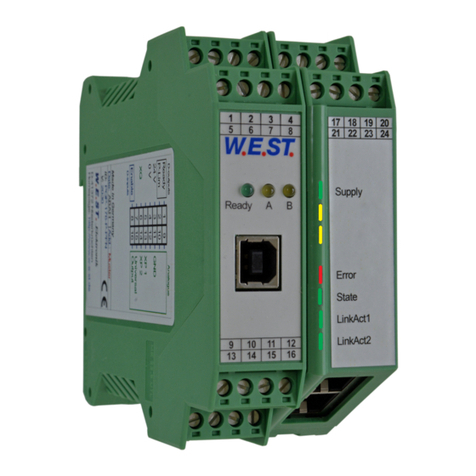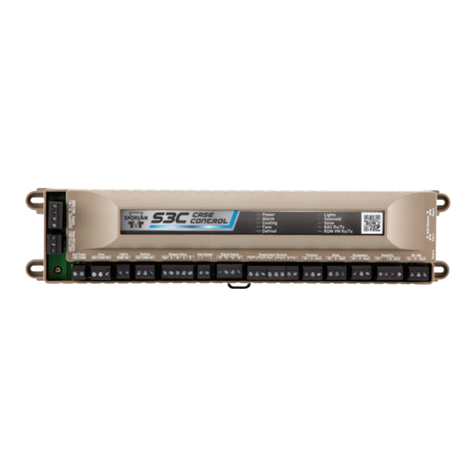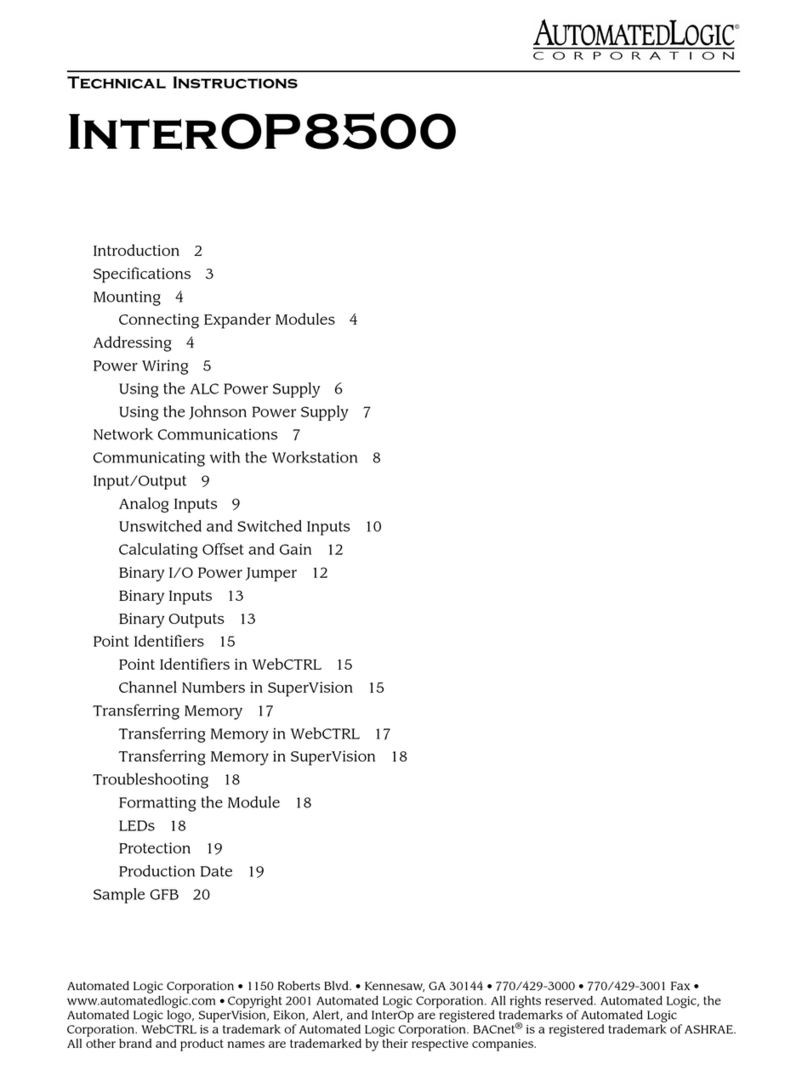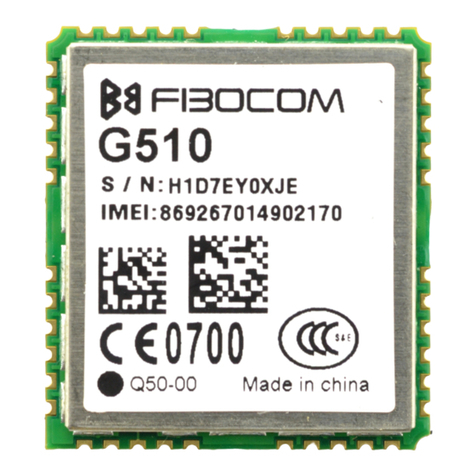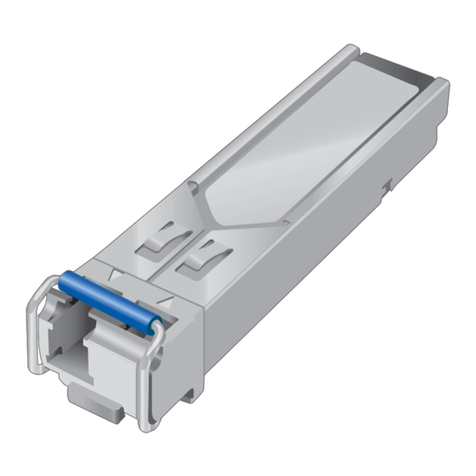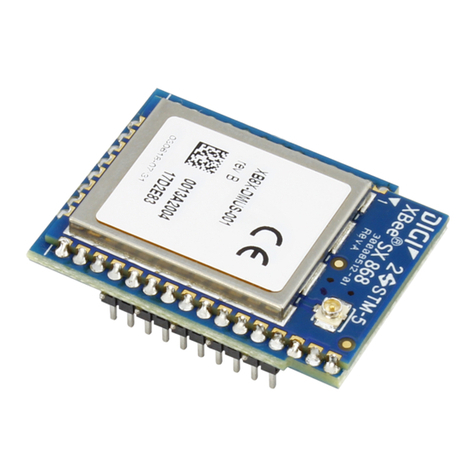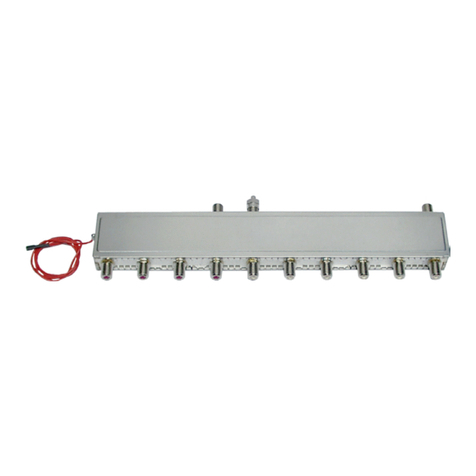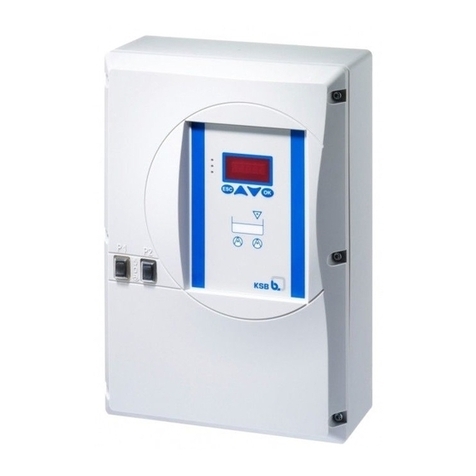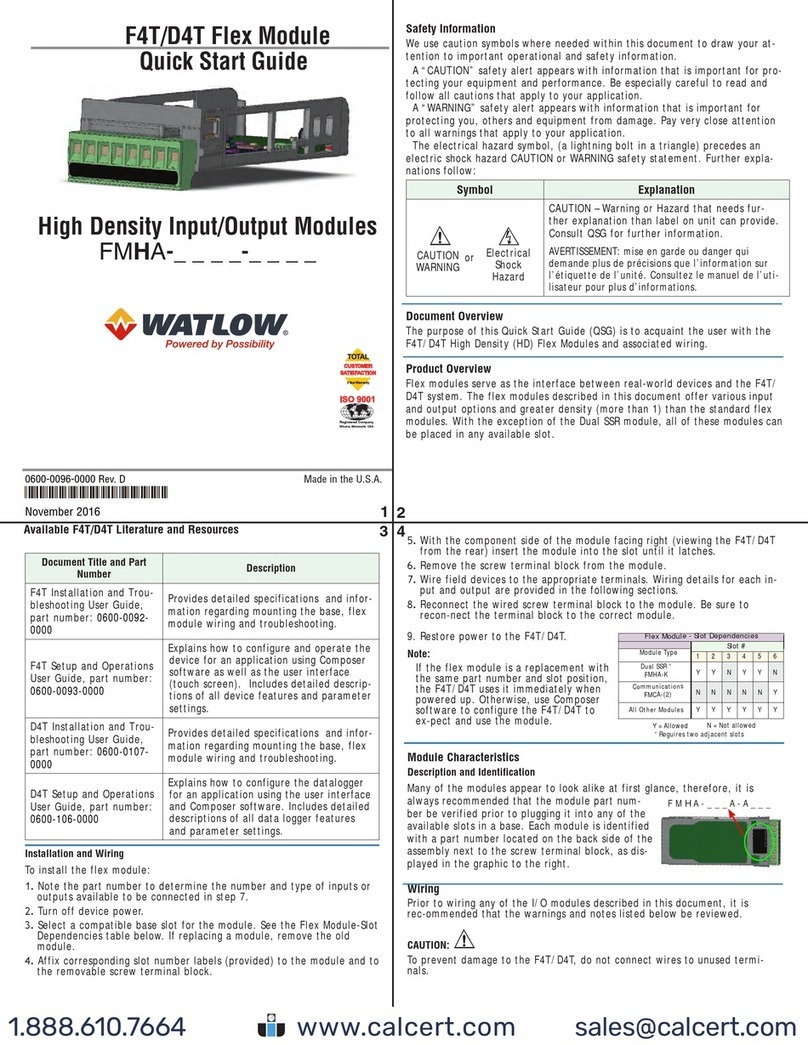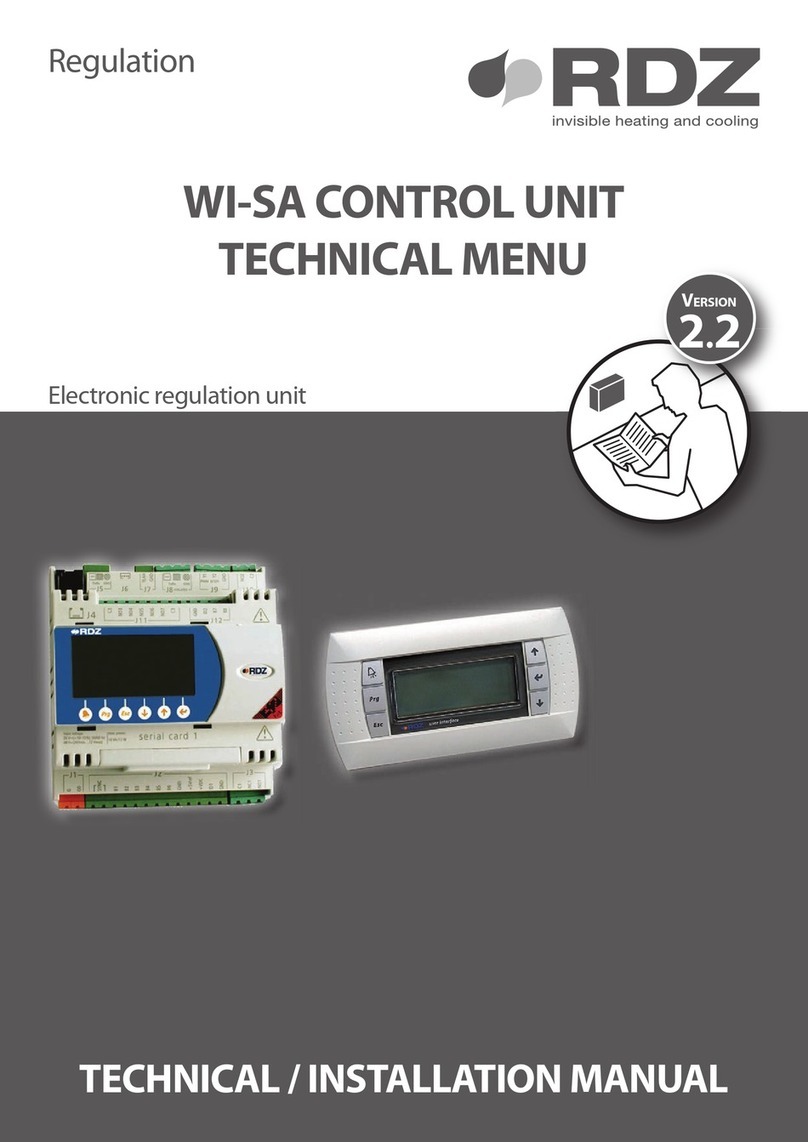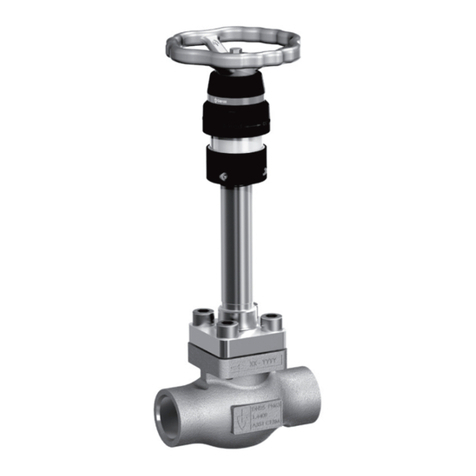Tellabs 4119 User manual

TCI Library www.telephonecollectors.info
Ttellabs®
Technical Manual
76.814119/S-A
November
3,
1995
Practice Section 814119/814119S
©1995 Tellabs Operations, Inc.
All Rights Reserved, Printed
in
USA
4119 and 4119S Echo Canceller Modules
Contents
1.
General
Section 1. General.
...
Section 2. Applications.
Section 3. Installation. .
Section
4.
Circuit Description
Section 5. Block Diagram.
Section 6. Specifications .
Section 7. Testing, Technical Assistance, Repair and Return.
1
3
8
.14
.17
.18
.20
1.1
The 4119 and 4119S Echo Canceller Modules (hereafter referred to throughout this practice
as 4119/S, except where differentiation is necessary) are adaptive, split-type echo cancellers
intended for use near the end points of 4-wire transmission facilities that are characterized
by appreciable propagation delay. Echo caused by signal reflections from impedance dis-
continuities and interface points (e.g., 4-wire to 2-wire interfaces) are effectively cancelled by
these modules during Voice Frequency (VF) transmission. Therefore, the 4119/S is espe-
cially well suited for use
in
single-hop and double-hop satellite circuits (whose round-trip
delays are about 600ms and 1200ms, respectively), and
in
long terrestrial circuits (those
with round-trip delays exceeding 50ms).
1.2 The 4119 and 4119S Modules are identical, except for the presence of circuitry on the 4119S
Module that disables echo cancellation during the presence of 2600Hz Single Frequency
(SF) signaling tone.
1.3
In
conventional applications, echo cancellers are located on the terminal equipment side of
SF signaling units and therefore do not have to contend with SF signaling tone. (This
is
the
intended application of the standard 4119 Module.) Certain applications, however, require
that an echo canceller be located within the SF signaling link, where SF tone may be present
in one or both directions.
In
such end link applications, the echo canceller must be transpar-
ent to SF tone transmission so that no interference occurs between SF signaling and echo
cancellation. This means that the canceller must contain circuitry that allows SF tone to
bypass its echo control sections. Such circuitry is provided on the 4119S Module. Upon
detection of continuous SF tone transmission in either or both channels, the 4119S Module
completely disables its echo cancellation and Non-Linear Processor (NLP) (residual echo
removal) sections. The SF tone is therefore passed unchanged and intact to the output
ports. Approximately 400ms after SF tone ceases, the module resumes its echo cancellation
and non-linear processing functions. The tone detection portion of the 4119S Module's dis-
abler circuitry is designed to allow for SF dial pulsing and also for loop start and ground start
operation on foreign exchange station end (FXS) and office end (FXO) circuits, where SF
tone is on during idle in one or both directions.
Tte11abs'"
is a registered U.S. trademark of Tellabs Operations, Inc. 1 of 24

TCI Library www.telephonecollectors.info
Practice Section 814119/814119S
1.4 As previously stated, the 4119/S is a split-type echo canceller, meaning that the 4119/S,
used at one end of a 4-wire circuit, protects the opposite end of the circuit from echo. There-
fore, when the 4119/S (or equivalent) is used at each end of a 4-wire circuit, the parties at
both ends are protected from echo.
1.5 Unlike
an
echo suppressor, which inserts a high impedance into the return path to attenuate
echo, the 4119/S digitally computes a highly accurate echo estimate based
on
the incoming
speech signal from the far end. This estimate is then subtracted from the transmit channel
(return path) signal. When the transmit signal consists of only echo, the echo is removed,
leaving
no
signal to be returned to the speaker. When the transmit signal consists of both
echo (from the far end speaker) and near end speech, only the echo
is
removed, leaving the
near end speech signal intact for transmission to the distant end. The 4119/S allows parties
at both ends to talk simultaneously. This is known as full duplex speech or "doubletalk".
1.6 Due to its completely adaptive nature, the 4119/S cancels echo
in
any circuit whose end
path (the path between the 4119/S and the near end terminating set) exhibits at least 6dB of
Echo Return Loss (ERL) and no more than 64ms of delay.
Note: End path delay consists of the round-trip propagation delay of all facilities in
the end path, fixed delays through transmission and switching equipment,
and line dispersion, which is typically 4 to 7ms with a 3400Hz bandwidth.
Reason for Change
1.7 This practice has been reissued to change the module specifications, and to incorporate
information from Addendum Section A814119S-A, dated 3/90.
4119/S Features and Options
2
1.8 Standard 4119/S features are as follows:
• Compliance with International Telegraph and Telephone Consultive Committee (CCITT)
recommendations G.164 (for tone disabler) and G.165
• Integral NLP for removing residual echo. A switch option conditions the NLP for operation
during both singletalk (only the far end party talking) and doubletalk
or,
per the above
CCITT recommendation, during singletalk only
• 3-position front panel switch that selects any of three operating modes:
-Normal (norm),
in
which all echo control circuits are active and the module is fully
operational
-Canceller Only (canclr only),
in
which the integral NLP is disabled, leaving only the
cancellation section operational
-Disable (disable),
in
which both the cancellation section and the NLP are disabled,
leaving only straight-through transmit and receive transmission paths for testing
• A switch option that conditions the modules for operation
on
end paths with a maximum
propagation delay of either 32 or 64ms
• Switch selectable, soft clipping operation, which adds a small amount of noise at the
transmit output to make operation of the canceller less noticeable on noisy end paths
• Integral tone disabler that, upon detection of
21
00Hz tone (indicating forthcoming data
transmission), disables all echo control circuitry. This renders the module completely
transparent
in
both directions for the duration of the data transmission
• Transformer coupling at all four transmission ports
• Balanced, switch selectable 1200-, 600-, or 150-ohm terminating impedance at the termi-
nal side (terrestrial side) ports (transmit input and receive output)
• Fixed, balanced, 600-ohm terminating impedance at the facility side (satellite side) ports
(receive input and transmit output)
• Switch selectable interface Transmission Level Points (TLPs), with a choice of
-16
trans-
mit and +7 receive,
-4
transmit and +4 receive, or 0 transmit and 0 receive at both the fa-
cility and terminal side ports
Rev A
11
/3/95

TCI Library www.telephonecollectors.info
Practice Section 814119/814119S
• Transmit and receive channel attenuators that each provide from Oto 24dB of prescrip-
tion set loss
in
0.1
dB increments, as selected via front panel DIP switches
• An input lead accessible at the module's card edge connector that, upon external appli-
cation of ground, disables all echo control circuitry for the duration of the ground
• Two front panel bantam-type monitoring jacks that bridge the transmit and receive pairs
on the module's facility side
• Two front panel indicator LEDs labeled diverge and disable; diverge lights during far end
speech to indicate a "diverged" condition, meaning that the module is unable to compute
a correct echo estimate, and disable lights when the echo control circuitry is disabled
• Operation on nominal
-24
or
-48VDC
input battery, with maximum power consumption of
1.8 watts
• Type-10 module packaging for mounting in a Tellabs Type-10 Mounting Shelf, versions of
which are available for relay rack (occupying 6 inches of vertical rack space) and appara-
tus case installation. Can also be mounted
in
a pre-wired Tellabs 262-Series Network
Channel Terminating Unit/Data Station Termination (NCTE/DST) Mounting Assembly
2.
Applications
2.1
The primary application of the 4119/S
is
in
4-wire single-hop and double-hop satellite circuits
whose round-trip delays are approximately 600 and 1200ms, respectively, and
in
4-wire ter-
restrial circuits with round-trip delays exceeding 50ms.
In
such long delay circuits, the oper-
ating characteristics of conventional echo suppressors can be objectionable, thereby
necessitating the use of echo cancellers.
2.2 The 4119/S functions well
in
any of the aforementioned circuits because its operation is
totally independent of canceller-to-canceller propagation delay. Naturally, the 4119/S can
also be used in circuits traditionally protected from echo by suppressors or through the use
of Via Net Loss (VNL) techniques.
2.3
In
conventional applications, echo cancellers are located on the terminal equipment side of
SF signaling units and therefore do not have to contend with SF signaling tone. This is an
application of the 4119 Module only, and is depicted
in
Figure 2-1.
A B C D
Local CO, PBX, 7
or Station I r Intermediate 7 r Intermediate 7
I Location I I Location I r -
LocalCO,
PBX~
- -
I or Station
!
-16 -16
1
_.
1_
16 4119 _161 I+7 4119 +71
1-----n-------1
t------t--'\
,._---t----H
">+-------<
I T
+7 e
r r
2Wire m ILong Delayl
Path I L
F m 2Wire
S +7
e
t
._
I
+71
1-16
I I -161 s
I
._
e
t
_________
_J
L
____
_J L
_______
_
End Link
(9dB Facility) Satellite
'4..--
I
◄
Path 1·
Figure 2-1 Typical 4119 Module ConventionalApplication
End Link
(5dB Facility)
Split-Type Echo Cancellation
Rev A
11
/3/95
2.4 Because it
is
a split-type echo canceller, one 4119/S (or equivalent) is required at each end
of a circuit to protect both parties from echo.
In
such an arrangement, point A is protected
from echo by the 4119/S at distant point
B,
and point B is protected from echo by the 4119/S
at point A. This split-type configuration makes the 4119/S completely insensitive to transmis-
sion delays over the long haul link.
2.5 While the 4119/S can be installed at one end of a circuit and a conventional echo suppressor
at the other, only the party at the end distant from the 4119/S benefits from its attributes; the
other party must contend with the usual echo suppressor operating characteristics.
3

TCI Library www.telephonecollectors.info
Practice Section 814119/814119S
Operating Modes
2.6 A 3-position slide switch
on
the front panel selects any of three operating modes:
• Normal (norm),
in
which both the echo cancellation circuity and NLP (for residual echo
removal) are active. This mode is selected for normal module operation.
• Canceller Only (canclr only),
in
which the echo cancellation circuity is active but the NLP
is disabled. This mode is used primarily during testing.
• Disable (disable),
in
which both the echo cancellation circuity and NLP are disabled,
thereby providing straight-through transmit and receive transmission paths. This mode is
used during alignment and testing.
Transmission Considerations
End
Path
ERL
Limits
2.7 For proper operation of the 4119/S, the ERL of the end path (the path between the 4119/S
and the near end terminating set from which echo is returned) must be 6dB or greater.
End
Path
Delay
Limits
2.8 Maximum round-trip delay of the end path served by a 4119/S must fall within the selected
signal processing window of Oto 32ms or Oto 64ms for proper operation of the echo cancel-
ler. When calculating end path delay, three factors must be considered:
• total round-trip propagation delay of all the facilities that make up the end path,
• fixed delays through transmission and switching equipment
in
the end path, and
• dispersion (spreading of energy) of those facilities, especially that of loaded cable and
the anti-aliasing filters used
in
channel banks
2.9 Total round-trip dispersion
in
end paths containing loaded cable and/or channel banks typi-
cally ranges from 4 to ?ms. Tables
2-1
and 2-2, and the example following them, may help
in
calculating end path delays. When making such calculations, note the following:
• The length of any transmission facility must always be doubled to obtain the total round-
trip distance.
• The 4119/S effectively cancels multiple echo on
an
end path as long as that echo does
not exceed the selected 32 or 64ms round-trip delay limit.
• For applications with longer end path round-trip delays of 32 to 64ms, the 64ms end path
delay option must always be selected.
Note:
With
the
64ms
option
selected,
the
Echo
Return
Loss
Enhancement
(ERLE)
provided
by
the
4119/S
is
approximately
2dB
lower
than
with
the
32ms
option.
Therefore,
instead
of
selecting
the
64ms
option
in
applications
where
end
path
delay
is
known
only
to
be
64ms
or
less,
Tellabs
recommends
that
end
path
delay calculations always
be
made
as
directed
to
ensure
the
best
possi-
ble
echo
cancellation performance.
4 Rev A 11/3/95

TCI Library www.telephonecollectors.info
Rev A
11
/3/95
Practice Section 814119/814119S
Transmission Approximate Wave Speed Approximate Propagation
Facility (Miles/Seconds) Delay (ms/Mile)
Loaded VF Cable 3,000 to 20,000 0.5 to 0.33
Non-Loaded VF Cable 50,000 0.02
T1
Carrier Line 94,000 to 125,000 0.008 to 0.0106
Fiber Optic Cable 100,000
0.01
L-Carrier Coaxial Cable 100,000 to 125,000 0.008 to
0.01
Terrestrial Microwave 140,000 0.007
Table2-1 Approximate Wave Speeds
of
Transmission Facilities
Transmission Equipment Fixed One-Way Delay
PCM Channel Bank 0.125 to 0.5ms (plus dispersion)
Digital Switch Up to 1.2ms
Transmux 1.8 to 6ms (each conversion)
M13 Mux 0.5ms
Digital Cross-Connect Systems 0.25ms
Note that the above delays are approximations. For delays of specific equipment, consult
manufacturer's literature. Also note that some Time Assigned Speech Interpolation (TASI)
facilities may exhibit more than 75ms of delay, making them unsuitable for both normal and
extended delay cancellers.
Table2-2 Approximate Delays Through Transmission/Switching Equipment
End Path Delay Calculation Example
Let's assume that the end path consists of the following:
• a channel bank
• a 500-mile
T1
line
• another channel bank
• 5 miles of loaded cable to the subscriber
Round-trip delay for this end path
is
calculated as follows:
• Round-trip delay of
T1
line
=500 miles x 2 (for round trip) x 1 second/100,000 miles
=
0.01
oo second = 1a.oms
• Round-trip delay of loaded cable
=5 miles x 2 (for round trip) x 1 second/10,000 miles
= 0.001 second = 1
ms
• Fixed delay of channel bank
= 0.125ms x 4 = 0.5ms
• Round-trip dispersion of channel banks and loaded cable
=?ms (estimated)
• Total end path round-trip delay
= 1a.oms + 1ms + 0.5ms + ?ms
= 18.5ms
This delay
is
well below the 32 or 64ms maximum end path delay for proper signal processing by
the 4119/S. Thus, the 4119/S provides effective echo cancellation for this end path.
5

TCI Library www.telephonecollectors.info
Practice Section 814119/814119S
End Path Signal Linearity
2.10 The 4119/S must be located at a point
in
an end path where its processed signals are nomi-
nally linear. If the 4119/S
is
located at a point where the signals are non-linear, e.g., after a
compressor but before an expander, its performance will be degraded. This
is
because the
4119/S always creates a linear end path model.
Convergence Time
2.11
In
normal operation, upon establishing a voice path the 4119/S begins an initial adaptation
process known as convergence.
In
convergence, the module constructs a mathematical
model of the near end path (terminating set and interconnecting facility) to calculate an echo
estimate. This convergence process is usually completed
in
200ms or less, depending upon
the signal level
in
the receive path. When the person at the distant end begins to talk, some
echo is initially heard, but this disappears upon convergence of the 4119/S at that end (typi-
cally, within two or three syllables of speech). The same convergence time
is
required by the
4119/S at the near end of the circuit, after which the transmission path is entirely free of
echo. Following convergence, doubletalk is possible without the usual choppiness and lock-
out that can occur on circuits served by conventional echo suppressors.
Operation During Singletalk and Doubletalk
2.12 During singletalk only, the end path model is continuously updated to provide the best possi-
ble echo cancellation. The 4119/S detects doubletalkwhen signals appearing in the transmit
channel are at approximately the same level as signals
in
the receive channel. When this
occurs, the adaptation process is unconditionally halted. Cancellation still takes place and
the signal that appears
in
the transmit channel consists of near end speech plus actual echo,
minus the estimated echo signal.
Suitability for Various Circuit Types
2.13 Internal adjustments and factory modifications are not required to condition the 4119/S for
use on a particular type of circuit. The module can be used in terrestrial circuits or single- or
double-hop satellite circuits just as it arrives from Tellabs. Because the 4119/S functions on a
"cross-correlative" basis with respect to speech and echo, rather than on the basis of level
detection and hangover time peculiar to echo suppressors, the 4119/S is less susceptible to
false operation induced either by echo or noise.
To
the 4119/S, the only functional difference
in
the aforementioned types of circuits is the length of time required to exchange words.
Facility Interface Levels
Level Control
2.14 The 4119/S
is
designed to interface the transmission facilities on its facility (satellite) and ter-
minal (terrestrial) sides at conventional
-16
transmit and +7 receive TLPs, via switch option,
at
-4
transmit and +4 receive TLPs, or at 0 transmit and 0 receive TLPs. These interface lev-
els can be independently selected at each module port. Overload occurs
in
each channel at
approximately 3dB above the selected TLP.
Note: Continuous signal levels exceeding the stated overload points can result
in
temporary divergence of the 4119/S.
2.15 On the terminal side, adjustable precision attenuators
in
both the transmit and receive chan-
nels provide for coordination between actual terminal side facility levels and the TLPs
selected for terminal side interface on the module. From Oto 24dB of attenuation,
in
0.1
dB
increments, can be introduced into each channel independently via front panel DIP switches.
6 Rev A 11/3/95

TCI Library www.telephonecollectors.info
Practice Section 814119/814119S
Terminating Impedances
2.16 Balanced 1200-, 600-, or 150-ohm terminating impedance can be selected via switch option
for both ports (transmit input and receive output)
on
the terminal (terrestrial) side of the
4119/S. The 1200-ohm option interfaces loaded cable, the 600-ohm option interfaces non-
loaded cable or a carrier channel, and the 150-ohm option provides a small amount of slope-
type amplitude equalization for non-loaded cable through the deliberate impedance mis-
match. Fixed, balanced, 600-ohm terminating impedance is provided at both ports (transmit
output and receive input)
on
the facility (satellite) side to interface the associated equipment
-normally, a co-located carrier channel -
on
that side.
Residual Echo Processing Modes
2.17 A switch option on the 4119/S selects either of two modes of residual echo processing.
•
In
the first, the integral NLP operates to remove any residual echo during both singletalk
and doubletalk.
•
In
the second, the NLP is disabled during doubletalk per CCITT recommendation G.165.
Note: With the front panel operating mode switch set to canclr only (canceller only),
the NLP is disabled entirely, i.e., during both single and doubletalk.
Normal or Soft Clipping Operation
2.18 Normal operation of the NLP temporarily quiets the residual echo resulting from the echo at
the transmit input along with any background noise from the end path. This results
in
momentary quieting of the transmit output to the far end talker.
If
the noise level of the end
path is relatively high, e.g., from old circuits, this momentary quieting can be noticeable.
To
make this effect less noticeable, a soft clipping switch option on the 4119/S can be set to
introduce a small amount of noise at its transmit output. Be aware that, although this option
makes operation of the 4119/S virtually undetectable to the far end talker, it can increase its
residual echo level to -60dBm0.
Integral
21
OOHz
Data Tone Disabler
2.19 Because it
is
generally preferred that echo cancellation not take place during the transmis-
sion of data, even though,
in
many applications, the presence of
an
echo canceller can actu-
ally enhance data transmission, the 4119/S contains an integral data tone disabler.
In
response to nominal
21
00Hz tone from a data modem or a disabling tone source, the tone
disabler disables all echo control circuitry of the 4119/S, rendering it transparent to data
transmission
in
both directions. Because data transmission is more tolerant of echo than
voice transmission, the circuit functions normallywithout echo cancellation
in
the data mode.
The 4119/S automatically returns to normal operation (the echo cancellation mode) when
data transmission on the circuit ceases
in
both directions. After resuming normal operation,
the 4119/S again requires a convergence interval prior to echo cancellation.
Self-Diagnostic Circuitry
2.20 The 4119/S contains integral self-diagnostic circuitry that provides continuous on-line moni-
toring of its echo cancellation performance.
If
the 4119/S cannot achieve convergence and
remains
in
a diverged condition, its front panel diverge LED lights during far end singletalk.
Tandem Path Applications
2.21
In
certain applications, a switching system sets up a tandem path involving two links that are
both equipped with echo control devices (see Figure 2-2).
If
the two intermediate devices -
those closest to the switch -are echo suppressors, these suppressors must be disabled by
the switch regardless of whether the distant end devices are echo cancellers or echo sup-
pressors.
If
the two intermediate devices are echo cancellers, these cancellers need not be
disabled by the switch regardless of whether the distant end devices are echo suppressors
Rev
A 11/3/95 7

TCI Library www.telephonecollectors.info
Practice Section 814119/814119S
Local Facility
to Termination
or echo cancellers. When possible, it
is
recommended that intermediate 4119/Ss be disabled
by application of ground (from the switch) to their external ground disable input leads (pin 18
or 43),
in
which case echo cancellation remains disabled for as long as the ground is
applied.
,(
Tandem Links \
Tandem
/ Switching "
Echo Echo System Echo Echo
Control Control Control Control
Device Device Device Device Local Facility
(Canceller (Canceller (Canceller (Canceller to Termination
or or or or
Suppressor) Suppressor) Suppressor) Suppressor)
Figure 2-2 Tandem Path Involving
Two
Links, Both
With
Echo Control Devices
3.
Installation
Inspection
Mounting
Connections
8
3.1
Visually inspect the 4119/S upon its arrival to detect any possible damage incurred during
shipment.
If
damage is noted, immediately file a claim with the carrier.
If
the module is
stored, re-inspect it prior to installation.
3.2 The 4119/S mounts
in
one position of a Tellabs Type-10 Mounting Shelf or
in
a pre-wired
Tellabs 262-Series NCTE/DST Mounting Assembly. The module plugs physically and electri-
cally into a 56-pin connector at the rear of its shelf or assembly position.
3.3 Before making any connections to the mounting shelf or assembly, make sure that the power
is off and modules are removed. Modules should be placed only after they are properly
optioned and after wiring is completed.
3.4 Table
3-1
lists external connections to the 4119/S. All connections are made via wire wrap-
ping to the 56-pin connector at the rear of the mounting shelf position. Pin numbers are
found on the body of the connector.
Rev A
11
/3/95

TCI Library www.telephonecollectors.info
Practice Section 814119/814119S
Connect to:
Pin#
Receive Input Tip (From Distant End, Facility [Satellite] Side) 7
Receive Input Ring (From Distant End, Facility [Satellite] Side) 13
Transmit Output Tip
(To
Distant End, Facility [Satellite] Side)
41
Transmit Output Ring
(To
Distant End, Facility [Satellite] Side) 47
Receive Output Tip
(To
Near End Term Set, Terminal [Terrestrial] Side) 5
Receive Output Ring
(To
Near End Term Set, Terminal [Terrestrial] Side) 15
Transmit Input Tip (From Near End Term Set, Terminal [Terrestrial] Side) 55
Transmit Input Ring (From Near End Term Set, Terminal [Terrestrial] Side) 49
External Ground Disable Input Lead 18 and 43
-BATT
(-22
to
-56VDC
Filtered, Ground Referenced) 35
GND (Ground) 17
Table
3-1
External Connections
to
41191S
Option Selection
3.5 Five option switches must be set before the 4119/S
is
placed into service. Two are 3-position
slide switches; the others are 4-position DIP switches. One slide switch is on the front panel.
The other, along with two of the DIP switches, is on the main printed circuit board. The third
DIP switch is on the large "baby" board. Locations of these switches are shown
in
Figure 3-1. The first 10 entries in Table 3-2 summarize all switch options and provide a con-
venient checklist that can be filled out either prior to installation for prescription optioning or
during installation to serve as a record for future reference. Refer to Figure
3-1
and
Table 3-2, and set each option switch on the 4119/S as required.
Rev
A 11/3/95 9

TCI Library www.telephonecollectors.info
Practice Section 814119/814119S
4119
Echo Canceller
+-
in
--i:::.
0.1
c=- 0.2
~
0.4
xmt
c=- 0.8
in
c=- 1.5 loss
c=- 3.0 (dB)
c=- 6.0
~
12.0
~norm
canclr only
disable
W
~:~out
rev
in
mon
@disable
@diverge
_+-in
c=-
0.1
~
0.2
rev
c=- 0.4
out
c=- 0-8 loss
c=- 1.5 (dB)
c=- 3.0
c=- 6.0
~12.0
814119
Front Panel
Bottom
View
➔
(J)r
- - 7
al
I
......
L - - _J
(/) 0
0)
-
'Tl
o~~
-I
-
(,.)
0
0
-INC
r
::::I
-I
'"O
z
z 0
0 JJ
JJ
s::
s::
1no~1
dll
N~O
6.6.
6.
olV\IX
vsv
6.
Vv-
6.
V
6.9~-
D
S2
□
+7VmV
1
+4/::,.
V!::,,
0V!::,,
V
RCV
IN
OUT ON
TLP
(TONE NORM
DISABLER)
321
OUTi
NORM
t t
~o~s
~~~~
•
~
Gv8
NI
1ti11FTCLP
64
CCITT
-16V!::,,!V
/\
-4!::,,V
6.s4T
XMTOW
V ON
TLP
IN
OUT
S2
IN
8 4 2 1
0
B
§
MAIN o
BOARD
~
T"" T""
U)
+-Top
View
t~~~~
O:d_1------===========------------
:~x~~x
1
Rcv
0V
6.V
ON
TLP
IN
OUT
Figure
3-1
Option andAlignment Switch Locations
10
Rev
A 11/3/95

TCI Library www.telephonecollectors.info
Practice Section 814119/814119S
Switch Option or Check-
Alignment Function Switch Selection Setting list
Operating Mode of Front Panel norm/ Normal operation (canceller norm
Echo Control canclr only/ circuitry and NLP active)
Circuitry disable Switch Canceller only (canceller circuitry canclr only
active, NLP disabled; used
during testing)
Disable (canceller circuitry and disable
NLP disabled; used during
alignment and testing)
Terminating
S1
1200 ohms (for loaded cable) 1200
Impedances at 600 ohms (for non-loaded cable) 600
Terminal Side
(Terrestrial Side) 150 ohms (extra slope 150
Ports (xmt in, rev out) equalization for non-loaded cable)
2100Hz Tone S101-1 Tone disabler enabled
(in
circuit)
IN
Disabler Operation Tone disabler disabled (out of OUT
circuit)
End Path Delay S101-2 32ms, maximum 32
Processing Window 64ms, maximum 64
Residual Echo S101-4 NLP enabled during singletalk norm
Processing Mode and doubletalk
(NLP)* NLP disabled during doubletalk CCITT
per CCITT rec. G.165
Soft Clipping S101-8 Enabled (to make canceller SFTCLP
Operation (Insertion operation less noticeable on noisy
of Small Amount of end paths)
Noise at xmt Output) Disabled norm
Receive Input TLP S2-8 and S2-4 +7TLP S2-8 OFF
S2-4 OFF
+4TLP S2-8 ON
S2-4 ON
0TLP S2-8 OFF
S2-4 ON
Receive OutputTLP (if S2-2 and
S2-1
+7TLP S2-2 OFF
not known and
S2-1
OFF
alignment
is
to be +4TLP S2-2 OFF
non-prescription,
S2-1
ON
initially select +7) 0TLP S2-2 ON
S2-1
OFF
Transmit Input TLP (if S4-8 and S4-4
-16TLP
S4-8 OFF
not known and S4-4 ON
alignment
is
to be
-4TLP
S4-8 ON
non-prescription, S4-4 OFF
initially select
-16)
0TLP S4-8 OFF
S4-4 OFF
Continued on Next Page
Table 3-2 Summaryand Checklist
of
4119
IS
Switch Options andAlignment Switch Settings
Rev A 11/3/95
11

TCI Library www.telephonecollectors.info
Practice Section 814119/814119S
Switch Option
or
Check-
Alignment Function Switch Selection Setting list
(Continued from S4-2 and
S4-1
-16TLP
S4-2
ON
previous page)
S4-1
OFF
-4TLP
S4-2 OFF
Transmit Output TLP
S4-1
ON
0TLP S4-2 OFF
S4-1
OFF
Transmit Input Front panel xmt
in
0.1dB
0.1
to
IN
Attenuation (loss)** loss DIP
switch**
0.2dB 0.2 to
IN
0.4dB 0.4 to
IN
0.8dB 0.8 to
IN
1.5dB 1.5 to
IN
3.0dB 3.0 to
IN
6.0dB 6.0 to
IN
12.0dB 12.0 to
IN
Receive Output Front panel
rev
out 0.1dB
0.1
to
IN
Attenuation (loss)
**
loss DIP switch** 0.2dB 0.2 to
IN
0.4dB 0.4 to
IN
0.8dB 0.8 to
IN
1.5dB 1.5 to
IN
3.0dB 3.0 to
IN
6.0dB 6.0 to
IN
12.0dB 12.0 to
IN
* Remember that residual echo processing takes place, i.e., the NLP
is
active, only when the front panel
operating mode switch
is
set to norm.
** The eight positions of the front panel xmt
in
loss and
rev
out loss DIP switches are cumulative. Total loss
(in
dB) introduced into a channel
is
the sum of that channel's loss DIP switch positions set to in.
Table 3-2 Summary and Checklist
of
4119
IS
Switch Options andAlignment Switch Settings
Alignment Overview
3.6
To
align the 4119/S, complete the following procedure:
1.
Set the receive channel loss to coordinate terminal (terrestrial) side output levels with the
facility (satellite) side interface level.
2.
Set the transmit channel loss to coordinate input levels from the terminal (terrestrial) side
with the facility (satellite) side interface level.
3.7 At alignment time, all option switches should already be properly set as described above.
Prescription Alignment
12
3.8 Because 4119/S alignment settings are controlled by front panel DIP switches, prescription
alignment of the module is possible.
In
prescription alignment, the rev out loss and xmt
in
loss switches are set
in
accordance with specifications
on
the Circuit Layout Record (CLR).
The last two entries
in
Table 3-2 summarize the alignment switch settings and provide a
checklist for prescription alignment.
To
use this part of Table 3-2, indicate required alignment
switch settings
in
the checklist column prior to installation. Then, at alignment time, align the
4119/S by setting each switch as indicated
in
the table (or on the CLR, if preferred).
Rev A
11
/3/95

TCI Library www.telephonecollectors.info
Practice
Section
814119/814119S
Pre-Alignment Tasks for Non-Prescription Alignment
3.9
In
non-prescription alignment, access to the appropriate ports is typically provided via
an
external jackfield. Before beginning actual alignment, be sure to do the following:
1.
Disable all of the echo control circuitry by setting the front panel operating mode switch to
the disable position or by grounding connector pin 18 or 43.
2.
Verify that TLP optioning is correct at all four of the ports. The proper terminal (terrestrial)
side TLPs may not be available from circuit records. Therefore, the following alignment
procedures take this into account and provide appropriate instructions for determining
correct TLP settings.
In
such cases, initially set the terminal (terrestrial) side TLPs for the
standard
-16
transmit and +7 receive.
In
contrast, the facility (satellite) side TLPs for
interface with what is normally co-located carrier equipment should be known and must
be properly set before alignment.
3.
Set all positions of the front panel xmt
in
loss and
rev
out loss DIP switches to out for zero
loss
in
each channel.
Note: Because the terminal (terrestrial) side port impedance settings are 1200, 600,
and 150 ohms, while most Transmission Measuring Sets (TMSs) provide 900-,
600-, and 135-ohm settings, observe the following guidelines to obtain correct
level measurements and settings when aligning the 4119/S:
•
If
the module is optioned for 150 ohms and you use the 135-ohm setting on the
TMS, the slight impedance mismatch can affect level measurements by as much as
0.5dB. Therefore, we recommend that you re-option the terminal (terrestrial) side
ports for 600 ohms (set switch
S1
to 600) and use the 600-ohm setting on the TMS.
When alignment is completed, reset
S1
for 150 ohms as required.
•
If
the module is optioned for 1200 ohms, do not use the 900-ohm setting on the
TMS. Instead, re-option the module for 600 ohms and use the 600-ohm setting on
the TMS. When alignment is completed, reset
S1
for 1200 ohms as required.
• If the
TMS
does not have independent transmit and receive impedance settings,
option both the TMS and the module for 600 ohms during alignment; reset
S1
as
required when alignment is completed.
Receive Channel Alignment
Rev
A
11
/3/95
3.10 Align the receive channel as follows:
1.
Arrange the transmit portion of a TMS for 1004Hz tone output at +?dBm if the receive
input port is optioned for a +7TLP, at +4dBm if the port is optioned for a +4TLP, or at
0dBm if the port is optioned for a 0TLP.
If
the TMS has a separate transmit impedance
setting, select 600 ohms. Connect this signal to the 4119/S
rev
in
port.
2.
Arrange the receive portion of the TMS for terminated measurement at the terminal (ter-
restrial) side impedance selected on the module.
If
this impedance is not available on the
TMS, see the note under paragraph 3.9 for instructions. Connect the receive portion of
the TMS to the 4119/S
rev
out port.
3.
Adjust the front panel
rev
out loss attenuator switches until the desired receive channel
output level is achieved, as indicated by the TMS.
If
the desired receive output level can-
not be achieved with the existing receive output TLP setting, select another TLP setting
that allows the desired level to be achieved.
13

TCI Library www.telephonecollectors.info
Practice Section 814119/814119S
Transmit Channel Alignment
3.11
Align the transmit channel as follows:
1.
From the CLR or from actual measurement, determine the level (in dBm) at the 4119/S's
transmit input port when 1004Hz alignment tone is being sent at the proper level from the
distant end of the terminal (terrestrial) side facility.
2.
Arrange the transmit portion of the TMS for 1004Hz tone output at the level determined
in
step
1,
and connect it to the 4119/S xmt
in
port.
If
the TMS has a separate transmit
impedance setting, select the impedance for which the terminal (terrestrial) side ports are
optioned.
If
this impedance is not available on the TMS, see the note under paragraph
3.9 for instructions. As
an
alternative to using the TMS as a tone source, request person-
nel at the distant end of the terminal (terrestrial) side facility to send 1004Hz alignment
tone as described above.
3.
Arrange the receive portion of the TMS for 600-ohm terminated measurement, and con-
nect it to the 4119/S xmt out port.
4.
Set the front panel xmt
in
loss attenuator switches to achieve exactly the transmit input
TLP (-16,
-4,
or
0)
selected
on
the module. For example, if the transmit input level is
+2.5dBm and the module is optioned for a
-4
transmit input
TLP,
you would adjust the
xmt
in
loss attenuator switches for 6.5dB of loss, which is the difference between +2.5
and
-4.
If
the existing transmit input TLP setting cannot be achieved via the xmt
in
loss
switches, re-option the module for a transmit input TLP that can be achieved, then reset
the xmt
in
loss switches to achieve that level. Note that this xmt
in
loss setting must be
precisely made if the module
is
to accurately provide the selected transmit output
TLP.
5.
At this time, the TMS should indicate either
-16,
-4,
or
OdBm,
corresponding to the
selected transmit output
TLP.
If
this is not the case, verify that you have performed steps
1 through 3 correctly, then carefully repeat step
4.
6.
Alignment of the 4119/S is now complete. Remove all test cords. If necessary, reset
switch
S1
for the proper terminal (terrestrial) side terminating impedances. Finally,
remove the module from the disabled state by setting the front panel operating mode
switch to norm or by removing the ground from connector pin 18 or 43.
4.
Circuit Description
Receive Path
Transmit Path
4.1
This circuit description will familiarize you with the 4119/S for engineering and application
purposes only. Attempts to troubleshoot the 4119/S internally are not recommended and
may void its warranty. Testing procedures should be limited to those described
in
Section
7.
To
aid your understanding of this circuit description, refer to the Block Diagram
in
Section
5.
4.2 A speech signal (from the far end) at the receive input port is connected to TLP buffer amp 1
by way of a balancing transformer (600-ohm impedance). TLP buffer amp 1 conditions this
signal (X) for processing by the bandpass filter and analog to digital converter. The signal is
then passed directly to the digital to analog converter, low pass filter, and TLP buffer amp
2.
The signal passes through the Oto 24dB attenuator before it reaches the receive output port
by way of
an
impedance matching (1200, 600, or 150 ohms) transformer.
4.3 A signal (near end speech and echo) at the transmit input port is connected to TLP buffer
amp 3 via
an
impedance matching (1200, 600 or 150 ohms) transformer and the Oto 24dB
attenuator. From TLP buffer amp
3,
this signal (Y) contains echo from the receive output port
and, when near end speech
is
present,
is
processed by the bandpass filter and analog to
digital converter. The Y signal is then passed to the summing junction
(L),
where the echo
cancellation circuitry subtracts the digital echo estimate (R) from the Y signal to obtain
an
error signal
(E).
The echo estimate (R) is derived through processing of the X signal by the
14 Rev A 11/3/95

TCI Library www.telephonecollectors.info
Practice Section 814119/814119S
one or two convolution processors (see paragraph 4.4).
If
the error signal contains any low-
level residual echo, the NLP operates to further attenuate that echo. The error signal
is
then
processed by the digital to analog converter and low pass filter and sent to TLP buffer amp
4.
The transmit output is isolated from TLP buffer amp 4 via a transformer (600 ohms).
Echo Cancellation
4.4 Actual echo cancellation is performed by one (with the 32ms end path delay option selected)
or two (with the 64ms option selected) Very Large Scale Integration (VLSI) circuit chips
called convolution processors. These devices receive their signal from the X path via that
path's bandpass filter and analog to digital converter. This digital X signal, which is stored in
companded A-law form,
is
convolved with the estimated end path impulse response (H) to
output a digital echo estimate that is a 12-bit number
in
twos complement form. This digital
echo estimate (R) is subtracted (in the digital domain) from the Y signal at the summing junc-
tion
in
the controller Integrated Circuit (IC) to obtain the error signal.
4.5 The control signals for updating the H estimate derived within the convolution processor(s)
are generated
in
the controller
IC
by the update control circuitry. The update control circuitry
compares the signal with various internal thresholds and X peaks (see paragraph 4.6) to
determine the update co-efficients.
Doubletalk Detector and Hangover Timer
4.6 The doubletalk detector and hangover timer circuitry is activated when the Y signal is large
compared to the output of the X-path peak detector. The doubletalk detector and hangover
timer's output is used to inhibit the update control circuitry, thereby preventing updating of
the convolution processor's H estimate during doubletalk.
Residual Echo Control
4.7 The NLP operates to prevent residual echo from reaching the transmit output port when
either of the following conditions exists:
• The NLP is not disabled via the front panel operating mode switch.
• No external disabling signal
is
detected. This signal can be a ground on pin 18 or 43, or it
can be nominal
21
00Hz disabling tone if the integral
21
00Hz tone disabler is enabled.
Disabling Cancellation
Rev A
11
/3/95
4.8 A red disable LED on the front panel lights when the module is disabled under any of the fol-
lowing conditions:
• The front panel operating mode switch is set to the disable position.
• Nominal
21
00Hz disabling tone is detected (when the integral
21
00Hz tone disabler is
enabled).
• Ground on pin 18 or 43 is detected.
• 2600Hz signaling tone
is
detected (4119S Module only)
4.9 When the front panel operating mode switch is set to the disable position, the co-efficients
in
the H register of the convolution processor(s) are all set to zero. When the contents of the H
register are zero, the echo estimate (R) is zero and, as a result, no echo estimate is sub-
tracted from the Y signal.
In
addition, the H register is reset to zero when any of the following
conditions exists:
• Nominal
21
00Hz disabling tone is detected (when the integral
21
00Hz tone disabler is
enabled).
• Ground on pin 18 or 43 is detected.
• The H divergence detector internal to the convolution processor(s) determines that the H
register is
in
a diverged state.
15

TCI Library www.telephonecollectors.info
Practice Section 814119/814119S
Integral Tone Disabler (per CCITT Recommendation G.164)
4.10 The integral
21
00Hz tone disabler monitors the X and Y signal paths for nominal
21
00Hz
data tone. When the
21
00Hz tone disabler detects this tone, it completely disables both the
echo cancellation section and the NLP for the duration of the data transmission, lighting the
front panel disable LED and resetting and holding at zero the H registers of the convolution
processor(s).
Divergence Monitor Circuit
Power Supply
16
4.11
The divergence monitor circuit monitors the amount of updating provided to the convolution
processor(s). An excessive amount of updating over a 200ms interval (except during the
convergence process when much updating
is
normal) is recognized by the divergence mon-
itor as a diverged condition, which causes the front panel diverge LED to light and flash
in
accordance with the activity occurring
in
the receive path.
4.12 A switching-type power supply converts
-22
to
-56VDC
filtered input to the +5,
-5,
+12, and
-12VDC
voltages used by the internal circuitry. This power supply is not
an
isolated supply
(see the Caution notice following paragraph 3.4 for details).
Rev A
11
/3/95
No cauton notice found (2/20/2020 S. Kerman)

TCI Library www.telephonecollectors.info
:a
(1)
<
J>
...
...
~
...
......
Transmit
Input
Key:
X - far end speech
Y - near end speech
R - echo estimate
E - Y-R (error signal)
H - impulse response
Terminal
(Terrestrial)
Side
-m•(
Ground 18
Disable
Input 43
5
Tip
Receive
Output
15
Ring
0
disable
I
XMT
IN
Loss I
0 to 24dB
Attenuator
disable I
S101-1
Rev Out Loss
0 to 24dB
Attenuator
Reset
Codec
Bandpass
Filter and
Analog to
Digital
Converter
r
Digital to
Analog
Converter
and
Low pass
Filter
Digital to
Analog
Converter
and
Low pass
Filter
Bandpass
Filter and
Analog to
Digital
Converter X
Codec
Controller
IC
Doubletalk
Detector and
Hangover
Timer
7
_J
+
12v...o..Jr---.
-12V
Power
Supply
+5V
-5V~L-~----'
Internal
Ground
Divergence
Monitor
17
GND
Transmit
Output
35
-BATT
Facility
(Satellite)
Side
Receive
Input
"C
~
-
c;·
(1)
f
!l
5·
:::,
c:,
...
.i:,.
...
...
~
...
.i:,.
...
...
(0
en

TCI Library www.telephonecollectors.info
Practice Section 814119/814119S
6.
Specifications
Common
Dynamic Range (Transmit and
Receive)
Frequency Response (Disable
Mode)
Return Loss
Signal to Distortion Ratio
Signal Processing Window
Minimum End Path Return Loss
for Convergence
in
Less Than
250ms
Total Harmonic Distortion
Insertion Loss
Terminating Impedances
Facility (Satellite) and Terminal
(Terrestrial) Side Transmission
Interface Levels
Terminal (Terrestrial) Side
Attenuation Range
Input Voltage Requirements
Input Current Requirements
Environmental
Operating Environment
Dimensions
Weight
Mounting
18
• +3 to
-60dBm0
• < ± 0.5dB, 300 to 3000Hz (re 1004Hz)
• > 20dB, all ports
• 33dB typical for input signal levels between
-30
and 0dBm at 1000Hz
• 0 to 32ms or 0 to 64ms, switch selectable
• 6dB
• < 1.5% (1.2%, typical) for 1000Hz signal at 0dBm input level
in
transmit or receive path
• 0 ±0.3dB at 1004Hz
• Transmit input and receive output (terminal [terrestrial] side ports):
150,600,
or 1200
ohms ± 10%, balanced, switch selectable
• Transmit output and receive input (facility [satellite] side ports): 600ohms ± 10% fixed,
balanced
• Transmit channel:
-16,
-4,
or 0TLP, independently switch selectable at both ports
• Receive channel: +7, +4, or 0TLP, independently switch selectable at both ports
• 0 to 24dB
in
0.1
dB increments, independently switch selectable
in
transmit and receive
channels
•
-22
to
-56VDC,
filtered, ground referenced
• At
-48VDC:
37mA, maximum (1.8W), 30mA, typical (1.44W)
• At
-24VDC:
75mA, maximum (1.8W), 60mA, typical (1.44W)
• Inrush current: 350mA, maximum
• +32°
to+
122° F (0° to +50° C), humidity 5 to 95% (no condensation)
• 5.58 inches (14.17cm) high
• 1.42 inches
(3.61
cm) wide
• 5.96 inches (15.14cm) deep
• 14.7 ounces (417 grams)
• Relay rack or apparatus case via one position of a Tellabs Type-10 mounting shelf; can
also be mounted
in
a Tellabs 262-Series NCTE/DST Mounting Assembly
Continued
on
Next Page
Rev A
11
/3/95

TCI Library www.telephonecollectors.info
Practice Section 814119/814119S
Echo Cancellation and Non-Linear Processing
Residual Echo Level (REL) per
CCITT Recommendation G.165
for Receive Input Level of
-30
to
-10dBm0
Echo Return Loss Enhancement
(ERLE) During Doubletalk
Convergence Rate
20
in 15
~
w
_J
a:
w 10
5
0
Specifications Continued
•
REL~
-40dBm0
in
canceller only mode
•
REL~
-65dBm0
in
normal mode
• ERLE;;:: 20dB for signal at
-1
0dBm input level and with 6dB ERL
• For additional ERLE performance information, see Figure
6-1
(shows ERLE with 32ms
end path delay; ERLE is approximately 2dB lower with 64ms end path delay)
• 90% of ERLE attained in 200ms or less, with receive input signals at
-1
0dBm0 and ERL
of 6dB
Input Level
-10dBm0
-20dBm0
-30dBm0
ERLE as a function
of input level and ERL
0 5 10 15 20
ERL (dB)
Figure
6-1
ERL
and ERLE During Doubletalk
Integral Tone Disabler
Detection Band
Detection Threshold
Disable Operate Time
Disable Release Delay
Signal to Noise Ratio to Allow
Disabling
Disabler Recycle Time
Hold Signal Bandwidth After
Disabling
Guard Band
Rev A
11
/3/95
•
201
0 to 2240Hz
•
-31dBm0
• 300 ± 100ms
• 250 ± 150ms
• 0 to 5dB
• 30 ± 10ms
• 300 to 3800Hz, typical
• 500 to 1700Hz
Continued on Next Page
19

TCI Library www.telephonecollectors.info
Practice Section 814119/814119S
Disabler Circuit (4119S Module Only)
Specifications Continued
SF Tone Detection Level Range •
-20dBm0
and above
SF Tone Detection Frequency • 2600 ± 15Hz
Band
Signal to Guard Ratio • 6dB, typical
Detection Time • 40ms, typical
Hangover Time • 400 ± 50ms
Guard Band • 800 to 2450Hz
7.
Testing, Technical Assistance, Repair
and
Return
20
7.1
The following testing guide (Table 7-1) will assist in the installation, testing, and troubleshoot-
ing of the 4119/S, and will aid
in
the localization of trouble to this specific equipment.
If
tech-
nical assistance
is
required, refer to paragraph 7.2 for phone numbers.
If
the equipment
seems to be defective, substitute new equipment (if possible), and conduct the test again.
If
the substitute operates correctly, the original should be considered defective and returned to
Tellabs for repair or replacement, as directed in paragraph 7.3. We strongly recommend that
no internal (component-level) testing or repairs be attempted on the equipment; unautho-
rized testing or repairs may void its warranty.
Notes:
1. The testing procedures for this equipment are better performed when an external
jackfield is used for access to the appropriate ports of the module. The following
procedures are based upon the assumption that a jackfield will be used.
2.
White noise is the recommended test signal input. A sine wave input is not recom-
mended because such tones do not represent actual conditions encountered
in
end to end circuits. Furthermore, sine waves yield improper convergence read-
ings. For these same reasons, pseudo random noise generators with digital shift
registers are also not recommended.
3. Suggested test equipment is a General Radio 1381 Noise Generator Set arranged
for a SkHz bandwidth and a 2 conductivity level, or the noise generator portion of a
Wiltron 9041 Return Loss Measuring Test Set with appropriate level attenuation.
4. Recommended test signal input level to the 4119/S is 60 to 80dBrnC0
(-30
to
-10dBm0).
5. End path circuitry should be free of non-linear signals, such as those caused by
compressors, TASI systems, excessive quantizing distortion, and time variable
signal delays.
6. For specialized echo canceller testing procedures, consult CCITT recommendation
G.165.
Rev A
11
/3/95
This manual suits for next models
1
Table of contents

